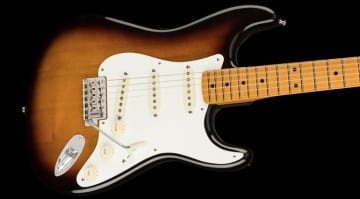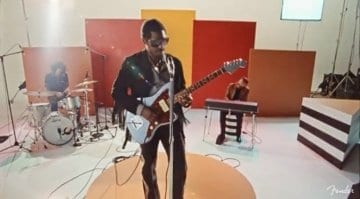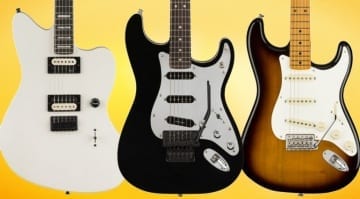Eric Johnson’s Gear: The Best Guitarists of All Time
The Sound of Cliffs of Dover
When guitarists discuss the “holy grail” of guitar sounds, one name emerges with remarkable regularity: Eric Johnson. The Texas-born virtuoso is considered one of the world’s greatest perfectionists when it comes to the electric guitar. He is a musician who can spend hours trying to make the sound a little clearer, rounder, or “just right.” Johnson is an uncompromising artist who blends blues, rock, jazz, and country to create his own unique style. Now, let’s take a closer look at Eric Johnson’s gear!
All About Eric Johnson’s Gear
Eric Johnson’s song “Cliffs of Dover” won him a Grammy in 1992 and remains a piece of guitar history played in countless living rooms, rehearsal spaces, and YouTube tutorials. Few guitarists can sound as technically brilliant, melodically accessible, and emotionally touching as Johnson does.
Born in Austin, Texas, in 1954, Johnson grew up in a musical family. Inspired by greats such as Jimi Hendrix, Wes Montgomery, and Chet Atkins, he started playing guitar at the age of eleven. His ability to transcend musical boundaries effortlessly became evident early on. While most teenagers followed one style, Johnson immersed himself in fusion, rock, and jazz. At 24, he formed his band, The Electromagnets, and began a solo career that propelled him into the top echelon of guitarists.
His discography is modest, yet his influence is immense. Albums such as Ah Via Musicom (1990) and Venus Isle (1996) remain essential listening for anyone interested in the potential of a Stratocaster, tube amp, and pedals. Johnson is also a prime example of how sound aesthetics and musical philosophy are inextricably linked – when you listen to him, you hear a vision of perfection.
Eric Johnson’s Style
What makes Eric Johnson’s style so special? The short, precise, and analytically brilliant answer is: everything. The long answer requires examining three aspects: his phrasing, tone aesthetics, and stylistic versatility.
Melodic Playing and Phrasing
While many 1980s virtuosos stood out primarily for their speed and technical tricks, Johnson always focused on musical melodies. Even in fast passages, each note sounds deliberate. His tone has a “singing” quality often described as a “violin sound“: long, clear, and free of background noise. This is due not only to his gear but also to his right hand, which he uses with extreme precision. Johnson mixes pick playing with fingerpicking to achieve dynamic control that is almost orchestral. He uses string muting and other techniques.
Sound Aesthetics and the Legendary “Violin Sound”
The term “violin sound” is not a marketing gimmick, but rather the result of an almost manic search for “purity” – I can’t think of a better word right now. Johnson combines light distortion, often via a Tube Screamer or directly from the Marshall Plexi, with delicate delay and a touch of reverb. He avoids harsh attack noises, shaping round note bows that stand in the room like string lines.
Johnson is also known for his obsession with detail. He claims to be able to hear the brands of cables and even the types of batteries in pedals in the sound. Whether this is a myth or the truth, his attitude (and his music) secures him a place in the Hall of Fame of all guitarists.
Who knows? Maybe it’s just my batteries.
Stylistic Versatility
Johnson is difficult to pigeonhole. In “Cliffs of Dover,” you can hear his rock side; in ballads like “Song for Lynette,” his romantic, almost classical side; and in jazz-oriented pieces like “East Wes,” his admiration for guitar heroes like Wes Montgomery. Country elements even appear in his solos, often as lightning-fast licks with a banjo-like character.
Johnson embodies a quality that has become rare today: genuine stylistic breadth without losing his recognizability. Whether he’s playing fusion, blues, or rock, you know it’s Eric Johnson after just a few notes.
Of course, most of the sound comes from his fingers. But Eric Johnson’s gear also plays a role in the final product. And that’s what it’s all about, isn’t it? So let’s get started.
The Guitars

When you think of Eric Johnson’s gear, the Stratocaster is probably the first thing that comes to mind. However, his guitar collection is more diverse than you might initially realize. He is primarily known for his iconic Strat sound, but he also uses other instruments depending on the song and mood. Here it is: Eric Johnson’s gear, starting (as always) with the guitars.
Fender Stratocaster – the Heart of the Matter!
The Fender Stratocaster is inextricably linked to Johnson. Back in the ’70s, he was often seen playing old models from the early ’60s. These guitars are still his main tools today, and it’s no coincidence that Fender released several Eric Johnson Signature Strats.
Johnson is known for optimizing every detail of his Strats, from the pickups to the neck profiles to the string saddles, so it’s particularly exciting that Fender released these guitars. He prefers lightweight guitars because he believes they resonate better. The pickups are mostly vintage-style single coils that sound extremely clear and bell-like without being harsh. They are, of course, also available as Fender signature models.
During live performances, he is often seen with a two-tone sunburst Stratocaster, which has long since achieved cult status. It delivers the sound many associate with “Cliffs of Dover“: warm, transparent, and assertive.
The Gibson ES-335: The Jazz Side
Although the Stratocaster is Eric Johnson’s main instrument, his gear has more to offer, such as the Gibson ES-335. He shows his jazzy side with this guitar and pays homage to greats such as Larry Carlton and Wes Montgomery. Its semi-hollow body produces a fat, round tone that is perfect for ballads and fusion pieces.
Johnson uses the 335 for studio recordings when he wants a fuller, warmer sound. Even with the Gibson, his tone remains unmistakable – he brings that “singing” quality we know from his Strats.
Les Pauls and Other Classics
Although he doesn’t perform on stage constantly, Eric Johnson has definitely used Gibson Les Pauls throughout his career. They come into play, especially when he needs a rich rock sound. The difference is particularly noticeable on older recordings: more mids, more sustain, and less “glassiness” than with the Strat – the typical Gibson Les Paul sound.
In addition to the classics, exotic instruments also regularly appear in his setup. These include acoustic guitars, such as Martin guitars, which he uses for quieter, more folky pieces. He has also played a Rickenbacker 12-string for shimmering soundscapes that you wouldn’t necessarily expect from him.
The Amps

Eric Johnson‘s talent goes beyond guitars. It’s only when he combines them with his amps that his famous “violin tone” is produced, which is still considered the benchmark today. Johnson doesn’t rely on a single model; he combines several amplifiers to achieve different tones. Let’s take a look at the amps in Eric Johnson’s setup.
Fender Deluxe Reverb and Twin Reverb – The Clean Sound
His clean sound is almost as legendary as his leads. Johnson has relied on Fender amps, especially the Deluxe Reverb and the Twin Reverb, for decades. These amps deliver bell-like highs and a warm foundation that harmonize perfectly with his Stratocaster single coils.
Interestingly, Johnson often runs the amps relatively clean, using only a little compression from the tubes to make the notes sound round and balanced. This sound is the backbone of his ballads and fusion-oriented pieces.
Marshall Plexi 100W – The Rock Side
But Eric Johnson wouldn’t be Eric Johnson if he were satisfied with clean tones alone. For his lead sounds, he uses a 100-watt Marshall Plexi Super Lead – an amplifier that Hendrix, Clapton, and Page also used.
Johnson usually runs the Plexi in the sweet spot, with just enough gain to create sustain and warmth without losing clarity. This produces the classic singing tone that is both cutting and flattering.
The Art of Combination
What’s really special isn’t the amps themselves, but how Johnson combines them. Live, he often uses several amplifiers at the same time, each playing a different role.
- A Fender Deluxe Reverb or Twin Reverb for the clean channel
- A Marshall Plexi is used for leads and crunch
This setup allows him to effortlessly switch between crystal-clear arpeggios and singing solos within the same song, often with both amps sounding simultaneously to create a broad soundscape.
I recently wrote about using stereo with guitars (on GEARNEWS.de). Take a look!
Effects in Eric Johnson’s Gear
When it comes to pedals, his gear is all about perfection. His ability to distinguish the brand of a 9-volt battery by its sound is legendary – and even if not everyone understands (or believes) this, it clearly shows how seriously he takes his sound.
Overdrive and Fuzz are the Heart of the Lead Sound
The most famous component of his pedalboard is the Ibanez Tube Screamer, usually a TS808 or vintage version. Johnson doesn’t use it to create extreme distortion; rather, he uses it to slightly boost the Marshall Plexi and extend its sustain. The result is a smooth, buttery lead tone that never sounds muddy.
For more bite and character, he occasionally uses a Dallas-Arbiter Fuzz Face, similar to what Hendrix did. However, he uses fuzz sparingly – like a spice, not a main course.
Delay and Echo: Space and Depth
Another trademark of his sound is the spatial dimension he creates with delays. One particularly popular device is the Maestro Echoplex EP-3, a legendary tape echo that adds warmth and depth to his tone. He also later used analog delays from Boss, such as the DM-2.
Important: Johnson usually sets his delays to be short and subtle. They shouldn’t overlay the sound; rather, they should act as a kind of cushion that gives the notes more body.
Reverb, Chorus, and Compression
Reverb is also indispensable for Johnson. He often relies on the spring reverb tanks of his Fender amps. He occasionally uses chorus effects for additional modulation, but very subtly, to broaden the sound without making it sound artificial. He almost always uses a compressor to make his extremely controlled playing style sound more homogeneous. Johnson prefers transparent models that give the tone more sustain without coloring it.
Strings, Picks, and Accessories
With a perfectionist like Johnson, it’s no surprise that he’s also extremely picky about strings and picks.
- Strings: Johnson prefers lighter sets, typically .010, which give him enough room for bending without sacrificing tone. He prefers fresh strings because dull highs are a deal-breaker for him.
- Picks: He often uses Dunlop Jazz III picks, which allow for precise response thanks to their small size and pointed tip. This enables him to control his lightning-fast runs and his long, singing notes.
- Cables & Batteries: Johnson is known for being able to hear the difference between alkaline and carbon-zinc batteries in his pedal. Whether this is a myth or reality, it fits the image of a perfectionist.
Influence and Legacy
Although Eric Johnson has released relatively few albums, his influence on the guitar world is enormous.
Guitarists such as Joe Bonamassa, John Mayer, and Guthrie Govan cite him as a role model. Johnson’s blend of technical brilliance and musical sensitivity proves that virtuosity can be both passionate and soulful. Eric Johnson embodies the idea of the guitarist as a seeker – never satisfied and always on the hunt for an even better sound – better than anyone else in the genre.
To this day, he inspires guitarists to dive deeper into the world of sound and expression, rather than settling for the obvious. This philosophy of sound and perfection is why I consider Eric Johnson to be one of the best guitarists of all time. What do you think? Feel free to let me know in the comments!
This article was originally written by Jan Rotring for GEARNEWS.de.
*Note: This article about Eric Johnson’s gear contains affiliate links that help fund our site. Don’t worry – the price remains the same for you! If you purchase something through these links, we receive a small commission. Thank you for your support!
One response to “Eric Johnson’s Gear: The Best Guitarists of All Time”

 4,1 / 5,0 |
4,1 / 5,0 | 








Cliffs of Dover, that kinda says it all. one of the Best IMHO.